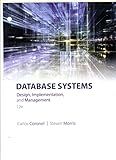Best Database Management Tools to Buy in December 2025

Database Systems: Design, Implementation, & Management



Database Systems: Design, Implementation, & Management



Concepts of Database Management (MindTap Course List)



Data Mining: Practical Machine Learning Tools and Techniques (Morgan Kaufmann Series in Data Management Systems)
- EXCLUSIVE 'NEW' FEATURES ATTRACT EARLY ADOPTERS INSTANTLY!
- ENHANCED PERFORMANCE GUARANTEES CUSTOMER SATISFACTION AND TRUST.
- LIMITED-TIME OFFERS CREATE URGENCY TO BOOST IMMEDIATE SALES!



Concepts of Database Management



Customer Relationship Management: Concept, Strategy, and Tools (Springer Texts in Business and Economics)



The Enterprise Data Catalog: Improve Data Discovery, Ensure Data Governance, and Enable Innovation



The Manga Guide to Databases (The Manga Guides)



Data Mining: Practical Machine Learning Tools and Techniques (The Morgan Kaufmann Series in Data Management Systems)


To update multiple columns in one table in Oracle, you can use the UPDATE statement with a set clause for each column you want to update. Simply specify the column names and their new values after the SET keyword, separating each pair with a comma. For example:
UPDATE table_name SET column1 = value1, column2 = value2, column3 = value3 WHERE condition;
Make sure to include a WHERE clause to specify which rows you want to update. This can be done by providing a condition that matches the rows you want to modify. Without a WHERE clause, all rows in the table will be updated with the specified values.
How to update multiple columns in Oracle while minimizing downtime?
One way to update multiple columns in Oracle while minimizing downtime is to use the following steps:
- Perform the update during off-peak hours: Schedule the update during times when the database is least used to minimize the impact on users.
- Use batch updates: Instead of updating each row individually, update multiple rows at once using batch processing. This can help reduce the overall time needed to complete the update.
- Use Online Table Redefinition: If available, use Oracle's Online Table Redefinition feature to update the columns without locking the entire table. This allows for the update to be applied without disrupting access to the table.
- Split the update into smaller transactions: If possible, split the update into smaller transactions to minimize the impact on the database. This can help reduce the amount of time the table is locked during the update.
- Test the update in a staging environment: Before performing the update in production, test it in a staging environment to ensure that it runs smoothly and does not cause any unexpected issues.
By following these steps, you can update multiple columns in Oracle while minimizing downtime and ensuring that the update is applied smoothly and efficiently.
What is the performance impact of updating multiple columns in Oracle?
Updating multiple columns in Oracle can have a performance impact, especially if the table being updated has a large number of rows or if complex calculations are involved in the update.
One way to minimize the performance impact of updating multiple columns in Oracle is to ensure that proper indexes are in place for the columns being updated. This can help Oracle access the necessary rows more quickly and efficiently.
Additionally, updating columns that are frequently accessed or involved in critical business logic may impact overall system performance, as it may cause locks on the table or additional overhead for the database to process the updates.
It is important to carefully consider the design of the database, the frequency of updates, and the potential impact on performance before updating multiple columns in Oracle. It may be beneficial in some cases to batch updates or use stored procedures to optimize performance and minimize the impact on the system.
How to update multiple columns in Oracle without locking the table?
One way to update multiple columns in Oracle without locking the table is to use the "MERGE" statement. The MERGE statement allows you to update multiple columns in a table based on a condition without locking the entire table.
Here is an example of how you can use the MERGE statement to update multiple columns in Oracle:
MERGE INTO your_table t USING ( SELECT column1, column2 FROM your_table WHERE condition ) u ON (t.primary_key = u.primary_key) WHEN MATCHED THEN UPDATE SET t.column1 = u.column1, t.column2 = u.column2;
In this example, replace "your_table" with the name of your table, "column1" and "column2" with the names of the columns you want to update, and "primary_key" with the primary key of your table. Replace "condition" with the condition that determines which rows to update.
By using the MERGE statement in this way, you can update multiple columns in Oracle without locking the entire table.
How to update a large number of records with multiple columns in Oracle?
To update a large number of records with multiple columns in Oracle, you can use the following approach:
- Use the UPDATE statement with the SET clause to specify the columns that need to be updated. Here is the basic syntax of the UPDATE statement:
UPDATE table_name SET column1 = value1, column2 = value2, ... WHERE condition;
- If you are updating a large number of records, it is recommended to break the updates into smaller batches to prevent performance issues. You can use the ROWID or other criteria to split the updates into batches.
- Consider using bulk processing techniques such as PL/SQL FORALL and BULK COLLECT for more efficient processing of large datasets.
- Make sure to commit the changes after updating a batch of records to avoid any data inconsistencies.
- It is also important to create appropriate indexes on the columns that you are updating to improve the performance of the update operation.
- Test the update operation on a small subset of records before running it on the entire dataset to ensure that it works correctly and does not have any unintended consequences.
By following these steps, you can efficiently update a large number of records with multiple columns in Oracle.
How to update multiple columns in Oracle for all rows in a table?
You can update multiple columns in Oracle for all rows in a table using a single SQL statement. Here is an example of how you can achieve this:
UPDATE table_name SET column1 = value1, column2 = value2, column3 = value3
Replace table_name with the name of the table you want to update, column1, column2, and column3 with the names of the columns you want to update, and value1, value2, and value3 with the values you want to set for those columns.
Make sure to include a valid WHERE clause if you only want to update specific rows in the table. If you omit the WHERE clause, all rows in the table will be updated with the specified values.
